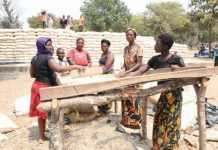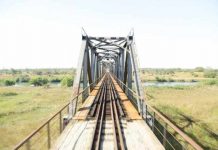KALUMBILA, the newest district whose foundation stone was laid by President Lungu a fortnight ago, is expected to be the first new city in Zambia since its independence.
President Lungu declared Kalumbila a district on Friday, August 28, 2015 during the commissioning of Kalumbila mine.
Unlike other recently declared districts which are nothing but villages, Kalumbila, catalysed by First Quantum, will start with a large proportion of necessary infrastructure in place.
A substantial amount of effort and investment has gone into developing the early stages of Kalumbila town.
This new city – aiming to be the happiest city in Zambia, if not Africa – is designed by Zambian engineers, planners, and property and environmental consultants and already houses more than 5,000 people, after only 18 months of establishment.
POPULATION
The population is expected to grow to over 15,000 by 2020 and by 2050 to potentially grow into a new Zambian powerhouse city, the size of Kitwe, based on growth in trade with Angola and Democratic Republic of Congo.
DRIVERS
The drivers of Kalumbila town are threefold:
Firstly, Kalumbila town lies outside the new US$2.1 billion Sentinel Copper Mine developed by First Quantum Minerals Limited (FQM), which will employ 1,788 direct staff and 1,276 locally based contractor personnel when fully operational.
Secondly, the 100-hectare Kalumbila Industrial Park has received strong interest with the first phase sold out and the first tenant moving in this week, and two large international corporate businesses locating their Zambian headquarters there, generating more than 400 jobs.
And finally, the main central business district consisting of shops, markets and offices will drive the expected strong growth of the town. Already, a 54-bedroom apartment hotel, a 1,000 square metre supermarket, ATMs from four banks, a petrol filling station and a 48 booth market square have opened, among others.
EXPECTATION
“We hope Kalumbila town and district [as a whole] goes from strength to strength in the future and can emulate other great Zambian towns which have started from new mines such as Solwezi, Kitwe or Chingola. The announcement came as a surprise and we are greatly humbled by the President’s declaration of Kalumbila as a district,” Frist Quantum public relations coordinator Mirriam Harmon says.
Already, the new Kalumbila town possesses centralised water, sewerage and electrical reticulation, bitumen main access roads, three schools, clinic, serviced filling station, four working ATMs (Zanaco, First National Bank, Stanbic, Stanchart) and a police station.
The ongoing commercial development of Kalumbila is managed by Kalumbila Town Development Corporation Limited (KTDC), which is a joint venture between Zambian Pension Fund and First Quantum.
Ms Harmon says KTDC will build integrated neighbourhoods with sound basic infrastructure and social technology that helps connect the citizens into a strong social fabric.
“To date, the town has been seeded with over 1,000 housing units financed by First Quantum, but external capital and developers will be required to help with the continued growth of the town.
“In addition, commercial, social, civil and communal infrastructure and spaces such as shops, hotels, offices, churches and schools will also need to be developed to enhance the town and to further ensure its long-term viability,” Ms Harmon says.
Importantly, the new Kalumbila town is located outside the mining area and is open for further investment.
“To date, many Zambians have already invested in the town and a number of home-grown businesses are being created in construction, farming and retailing, among others.
“The Trident Foundation, a not-for-profit organisation formed by First Quantum at the mine, is undertaking community development projects and programmes on customary land to ensure that the original inhabitants of the area are integrated into the development,” Ms Harmon says.
So the new Kalumbila, the district located off the Solwezi – Mwinilunga Road (T5), is starting life with substantial cornerstone planning and investment in place.
INVESTMENTS
To date, First Quantum has invested more than US$80 million in the development of Kalumbila town. This means the local authorities do not need to start from scratch at Kalumbila.
Ms Harmon says First Quantum has worked with Zambian engineers, planners and property and environmental consultants to develop an approved town plan for Kalumbila, which is to a high standard.
She says based on the approved town plan and environmental impact assessment, First Quantum has invested in road, sewerage, water and electricity infrastructure in the town.
INFRASTRUCTURE
“This infrastructure is part of several agreements with government authorities such as North-West Water and Sewerage Corporation, who will own and operate the assets under a public private partnership arrangement.
“Electrical connection of the new district is provided by the new Lumwana – Kalumbila – Mumbwa – Lusaka 330kV power lines constructed by First Quantum in partnership with Zesco. An international-standard airport is also under construction.
“It is envisaged that a multi-facility economic zone will cover the town to attract new businesses and further investment into the district. The developments are part of a Government Local Area Plan which has the potential to incorporate district headquarters,” Ms Harmon says.
GROWTH
Ms Harmon says as the district grows, the local authority will benefit from additional revenue from various services and businesses coming up in town. The long-term sustainability of Kalumbila town and district requires that it develops other businesses and opportunities outside just the mines.
TRANSITION
First Quantum management says the transition of Kalumbila to an independent district is a matter to be guided by government, particularly the Ministry of Local Government and Housing.
“In particular, it will be critical that the new Kalumbila town and district grows to a size which provides government and local authorities with the critical mass needed to properly manage services,” Ms Harmon says.
She says a larger town with more investment will enable the local authority to raise adequate funds for
service provision to the residents and businesses of the district.
“The long-term sustainability of Kalumbila town and district necessitate that other businesses and opportunities beyond just the mines, develop in the area. This may take some time. Although First Quantum has already provided the catalyst for Kalumbila town and the new district, we envisage that both First Quantum and KTDC will continue to have a strong interest in their ongoing development,” Ms Harmon says.
MASTER PLAN
The current Kalumbila Town Master Plan and Local Area Plans provide already serviced land and public infrastructure including sites for government offices and essential services such as the fire station.
The police station is already constructed and operational. There is potential for government to develop further facilities in the Local Area Plan and utilise the public infrastructure and services already put in place. The ongoing roll-out of infrastructure will require a coordinated effort.
DECENTRALISATION
First Quantum expects that the benefits may include decentralisation of rates and taxes to the local area. In addition, the presence of local authorities in the area will assist to expedite necessary development approvals for investors and help speed up economic growth in the area, leading to jobs.
“It is important that the town grows through other investors and other developers so it can reach the critical mass needed for adequate service provision.
“The town also needs to diversify away from just mining to ensure its long-term sustainability. We hope the presence of government as a development partner will help speed up further investment in the area,” Ms Harmon says.

 JOIN DRIVERN TAXI AS PARTNER DRIVER TODAY!
JOIN DRIVERN TAXI AS PARTNER DRIVER TODAY!











